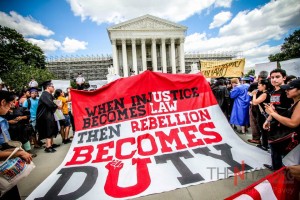Human Rights and Immigration Lawyer Contact Me
Affirmative Action Survives But Not For Long
My heart skipped a few beats today when the Supreme Court vacated and remanded Fisher v. Texas, to the Fifth Circuit, but affirmative action remains the law.
The Justices are so scared of race and racial politics that they said a few words about the compelling interest provided by diversity, and told the Fifth Circuit to apply the criteria set in Bakke v. California (race-based admissions policies should be narrowly tailored) because a showing of good faith by the University of Texas was not enough to overcome impermissible consideration of race. Universities must show there is “no workable race-neutral alternative” to achieving diversity. This anything-but-race approach to achieving a critical mass of diversity means that affirmative action survives, but it is still in a lot of trouble.
Lets make one thing clear. Achieving a race-neutral critical mass of diversity is not a convincing-enough rationale for affirmative action. It will not survive long. I’m not saying diversity is not a compelling government interest but I certainly question how, why and for whom it is important. Three years of law school at a rich, mostly-white private school has me thoroughly convinced that white people gain much more from interactions with people of color than we do from interactions with them. Justice O’ Connor made this point crystal clear in her majority opinion in the last affirmative action case where she praised diversity as a tool for providing legitimacy for government:
In order to cultivate a set of leaders with legitimacy in the eyes of the citizenry, it is necessary that the path to leadership be visibly open to talented and qualified individuals of every race and ethnicity. All members of our heterogeneous society must have confidence in the openness and integrity of the educational institutions that provide this training. (Grutter v. Bollinger)
Because having confidence in the legitimacy of government is a more overriding principle than actually addressing past and present discrimination, diversity becomes the overriding government interest in preserving affirmative action. Heavens forbid that people notice lingering racial segregation in their schools and housing patterns, and wake up to question why 60 years after Brown, we still live in an America so unequal.
The 7-1 remand from Fisher v. Texas has only one dissent: Ginsburg. And she shows again why she’s the only one who understands court-constructed 14th Amendment jurisprudence:
“I remain convinced ‘those that candidly disclose their consideration of race [are] preferable to those that conceal it’ […] ‘Actions designed to burden groups long denied full citizenship stature are not sensibly ranked with measures taken to hasten the day when entrenched discrimination and its aftereffects have been extirpated.'”
Ginsburg is criticizing the fallacy behind the constitutional jurisprudence that all use of race should be subjected to strict scrutiny in order to be upheld under the Fourteenth Amendment. This strict scrutiny test comes from the Supreme Court decision in Korematsu, where the Court declared that “all legal restrictions which curtail the civil rights of a single racial group are immediately suspect” (and then refused to apply the principle to the clearly unconstitutional internment of Japanese Americans). As opposed to Korematsu, affirmative action cases such as Bakke, Grutter and Fisher, do not “curtail the civil rights of a single racial group.” They, much like Brown v. Board of Education, involve the benign use of race to advance a legitimate government interest in tackling the vestiges of past and present discrimination, and promoting diversity. Thus, a strict reading of equal protection jurisprudence requires that strict scrutiny should be limited to “all legal restrictions that curtail the civil rights of a single racial group” as Ginsburg implies in her dissent.
Unfortunately, both benign and invidious uses of race get strict scrutiny. The Court has steadily moved away from encouraging the use of race in cases such as Brown v. Board of Education, to promoting colorblind constitutionalism as the way to guarantee equal protection. Colorblind constitutionalism is the proposition that the U.S. constitution, in treating all races equally, is colorblind. With its legal roots in Justice Harlan’s dissent in Plessy v. Ferguson, color-blindness espouses the questionable principle of race neutrality in a legal system that is constructed to generate and maintain disparity. Colorblind constitutionalism has gained more credence through the rhetoric of a post-racial America, and especially the re-election of President Obama. Supporters of color-blindness contend that we have moved beyond race and race is no longer relevant i.e. Parents Involved in Community Schools v. Seattle School Dist. No. 1 (“[T]he way to stop discrimination on the basis of race is to stop discriminating on the basis of race”). This is deeply problematic, as colorblindness threatens to blind us from the continuing reality of white privilege in American society and the institutional discrimination that persists, including gentrification, white-flight, re-segregation, spirit injury, legacy admits, and even micro-aggressions.
Espousing neutrality and colorblindness in a white supremacist order is not neutral—it is a raincheck for an unequal world. Race neutrality serves to legitimize the current racial order while making sure that systemic discrimination remains undisturbed. While some may argue that colorblindness is a laudable principle, it is in effect, a way to keep the racial pecking order while ignoring the very real impact of racism on everyday lives. Failure to see and acknowledge racial differences makes it difficult to recognize white privilege and systemic racism, and take action to address the impact of these on our lives.
Thus, colorblindness is a vestige of institutionalized racism. Race consciousness policies such as affirmative action are imperative to battling racism, and the benign use of race in order to do so should not rise to the level of strict scrutiny.
Ginsburg could have articulated all of this better, but for now, I’m glad affirmative action is still legal.
